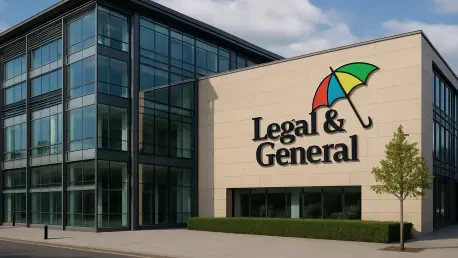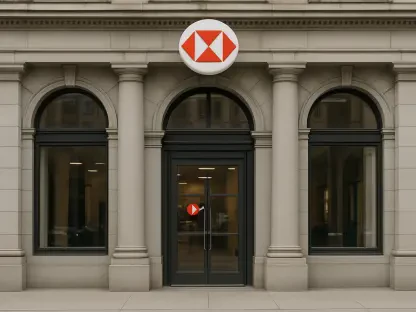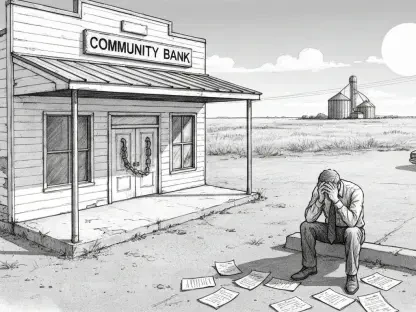What does it take to steer a financial giant through turbulent economic waters while posting record profits? Legal & General (L&G), a cornerstone of the British insurance industry, is grappling with this very question as it achieves staggering financial highs alongside unexpected hurdles. With a half-year core operating profit of 859 million pounds ($1.14 billion), the company stands as a beacon of success, yet a dip in financial resilience metrics casts a shadow over its achievements. This duality paints a vivid picture of a firm at a pivotal moment, navigating growth and uncertainty in equal measure.
The significance of L&G’s journey extends far beyond its boardroom. As a FTSE 100 titan, its performance serves as a barometer for the health of the broader financial sector, especially in an era marked by inflation, geopolitical instability, and shifting regulatory demands. For investors, policymakers, and industry watchers, understanding how this insurer adapts to challenges while capitalizing on opportunities offers critical insights into the future of global markets. This story is not just about numbers—it’s about resilience, strategy, and the evolving role of insurers in today’s economy.
A Financial Powerhouse at a Crossroads
Legal & General’s latest financial snapshot reveals a company riding a wave of success while facing undercurrents of concern. The half-year results showcase a 6% surge in core operating profit, reaching an impressive 859 million pounds, fueled by a booming pension buyout market where transactions doubled to 3.4 billion pounds. This achievement, surpassing analyst expectations, cements L&G’s dominance in transferring corporate pension liabilities—a niche but vital segment of the insurance landscape.
Yet, not all indicators point to smooth sailing. A decline in the solvency ratio from 223% to 217%, falling short of forecasts, has raised eyebrows among investors, particularly as currency fluctuations from a weaker U.S. dollar and shareholder payouts play a role. This dip contributed to a 3% drop in share price, despite a strong year-to-date performance prior to the earnings release, signaling market unease about financial stability.
Adding to the complexity, total operating profit slipped by 2% to 905 million pounds, reflecting struggles in non-core segments. Even so, the interim dividend held steady at 6.12 pence per share, meeting predictions and offering some reassurance to stakeholders. These mixed results highlight a firm excelling in targeted areas while wrestling with external pressures, setting the stage for strategic recalibration.
Why L&G’s Performance Matters in Today’s Economy
In a world of economic unpredictability, from volatile currencies to erratic trade policies, the stability of major insurers like L&G carries weight beyond corporate balance sheets. Their role as stewards of long-term financial security, particularly through pension buyouts, reflects broader trends in how businesses manage enduring liabilities. As companies increasingly transfer pension risks to insurers, L&G’s leadership in this arena signals a shift in corporate responsibility dynamics.
This influence resonates with a wide audience, including investors seeking reliable returns and policymakers monitoring systemic financial risks. The insurer’s ability to thrive amid inflation and geopolitical tensions offers a lens into the insurance sector’s adaptability. It also underscores the interconnectedness of global markets, where a single firm’s solvency metrics can ripple through investor confidence and economic forecasts.
Moreover, L&G’s performance highlights the stakes for employees and retirees who depend on pension stability. As a key player in the UK market, managing 1.1 trillion pounds in assets, its strategic decisions shape not just shareholder value but also societal trust in financial institutions. This broader impact makes tracking the company’s trajectory a matter of public interest.
Dissecting L&G’s Financial Wins and Warning Signs
Diving deeper into the numbers, the pension buyout segment emerges as a standout driver of L&G’s success. Transactions worth 3.4 billion pounds, more than double the previous figure, propelled core operating profit to new heights, outpacing market expectations. This surge reflects a growing corporate appetite for offloading pension obligations, positioning L&G as a trusted partner in managing these complex risks.
On the flip side, the solvency ratio’s decline to 217% has sparked concern, as it falls below anticipated levels. Factors like currency impacts from U.S. asset exposure and significant payouts to investors have strained this critical measure of financial health. The resulting 3% share price drop underscores how even minor deviations in key metrics can unsettle markets, despite other positive indicators.
Beyond these focal points, the broader financial picture shows a slight downturn in total operating profit, dipping to 905 million pounds. While the steady interim dividend offers some stability, the mixed outcomes reveal a company navigating a delicate balance. These figures collectively paint a portrait of strength in specialized growth areas, tempered by vulnerabilities that demand careful management.
Voices of Leadership and Industry Insight
CEO Antonio Simoes provides a steady hand amid this complex landscape, articulating a vision of cautious optimism. “Long-term opportunities in the U.S. market remain compelling, even with short-term volatility tied to trade policy unpredictability,” he notes, reflecting on global economic challenges. His perspective signals a commitment to strategic patience, prioritizing sustained growth over reactive shifts.
Industry trends bolster this outlook, as seen in L&G’s collaboration with Blackstone to explore private credit assets, a move mirroring the sector’s pivot toward direct lending. Analysts also point to a robust pipeline of pension buyout deals, with 42 billion pounds under active pricing, though they warn of rising competition from entrants like Brookfield. This competitive pressure adds a layer of urgency to L&G’s focus on core strengths.
Further context emerges from recent divestitures, such as the U.S. protection business and housebuilder Cala, which free up capital for shareholder returns and reinvestment. Simoes’ confidence in sustained demand for pension transactions, paired with these calculated moves, offers a narrative of deliberate focus. This leadership stance provides clarity amid market fluctuations, grounding the company’s direction in tangible action.
Strategies for Sustained Growth Amid Uncertainty
Examining L&G’s playbook reveals actionable strategies for thriving in volatile conditions, starting with a laser focus on core competencies. By divesting non-essential units like the U.S. protection business, the company redirects resources toward high-growth sectors such as pension buyouts and asset management. This streamlining ensures capital is allocated where it yields maximum impact.
Partnerships also play a pivotal role, with the alliance alongside Blackstone opening doors to private credit markets. Such collaborations diversify revenue streams while spreading risk, a prudent approach in an unpredictable economic climate. This tactic reflects a broader industry trend of insurers seeking innovative ways to bolster financial flexibility.
Finally, a long-term perspective guides L&G’s investment in markets like the U.S., despite currency challenges and policy uncertainties. Coupled with vigilant monitoring of solvency metrics to address investor concerns, this strategy balances immediate pressures with future potential. These pillars—specialization, collaboration, and foresight—offer a roadmap for any organization aiming to navigate growth and obstacles in tandem.
Reflecting on a Path Forward
Looking back, Legal & General demonstrated remarkable prowess with its half-year results, driven by a pension buyout boom, even as solvency concerns and market dynamics posed significant tests. Under Antonio Simoes’ stewardship, the company honed its focus on core insurance and asset management, leveraging partnerships to explore new frontiers. Each step, from divestitures to strategic investments, reflected a calculated effort to adapt to a competitive landscape.
As a next step, stakeholders should monitor how L&G addresses financial resilience metrics, particularly solvency, to rebuild investor trust. Exploring further diversification in asset classes could mitigate currency risks, while deepening expertise in pension transactions might solidify market leadership against rising competitors. These actions would strengthen an already robust foundation.
Beyond immediate tactics, the broader industry could benefit from studying this balance of aggressive growth and cautious restructuring. Consideration of regulatory changes and global economic shifts will be crucial for L&G and its peers in maintaining stability. This ongoing evolution, rooted in adaptability, promises to shape the insurer’s legacy in a challenging yet opportunity-rich environment.









